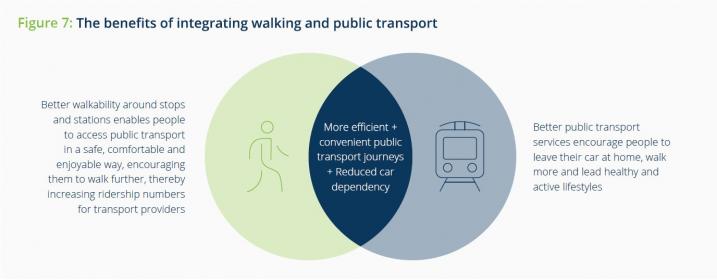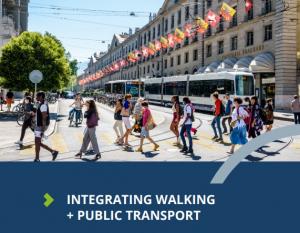Walking is a key component of a public transport journey. Travel surveys repeatedly show that nearly all public transport users walk as part of their trip. According to a study conducted in 12 European cities between 2016 and 2022 by the Research Institute Socialdata, Stavanger, München, an average of 91% of people using public transport walk from their starting point to public transport and 98% walk from public transport to their destination, rather than cycling or driving.
Another study from the National Household Travel Survey by the Federal Highway Administration in the United States shows similar levels of walking, with 80% of public transport users walking to the stations.
Between 65 and 70% of people’s memories of a travel experience come from their time spent as pedestrians – while waiting, in transit, and when walking to and from stops or stations – indicates the study done by the Research Institute Socialdata, Stavanger, München.

The new policy brief “Integrating Walking and Public Transport,” which was developed as part of the preparation of a pan-European master plan on walking under the Transport, Health and Environment Pan-European Programme (THE PEP), provides insights into how to support better integration between walking and public transport and reach a higher share of people walking and using public transport.
Fixing a missed connection
Promoting active mobility means providing good connections in public transport. The policy brief shows that better integration of walking and public transport enhances the popularity of both active mobility and public transport while reducing the use of private cars. In addition, it has a positive impact on:
-
Health and wellbeing;
-
Climate change mitigation, with a potential to reduce carbon emissions by as much as 50%;
-
Social equity, with people of various generations and social status using public transport and walking more often;
-
Public space efficiency and increased reliability of all trips;
-
Economic vitality due to active and public transport users spending more money at local businesses than people who drive;
-
City resilience and fiscal viability.
Yet, walking and public transport are often considered separately which devalues their complementary nature. The policy brief provides recommendations that can increase walking activity and public transport ridership by creating and promoting safe, accessible and comfortable walkable catchments to and from public transport stops and stations.
The policy brief presents the integration of walking and public transport as a key strategy for reducing the use of private cars, reducing carbon emissions and improving the fiscal viability of public transport services while enhancing urban efficiency and quality of life.
Key recommendations to increase the share of people walking and using public transport
A study of more than 50 Western European cities by the European Platform on Mobility Management (EPOMM) highlights that the cities with the highest levels of walking and public transport users also have less car traffic. The cities are categorised based on the percentage of car traffic, as well as their relationship between public transport use and walking activity.
Cities with a high percentage of car traffic tend to either have a low percentage of walking, or a low percentage of public transport use. As cities have a higher share of people walking and using public transport, car traffic reduces significantly.
To motivate a higher share of people to walk and use public transport, the policy brief proposes four core actions:
-
Promote physical health benefits, emotional wellbeing and transport cost savings in campaigns and messages;
-
Make routes pleasant, easy to access and safe for users;
-
Reduce the perception of distance and time by making walking and public transport more convenient than using cars;
-
Ensure that walking and public transport are planned holistically across sectors, levels of authority and funding mechanisms.
Creating proximity and high-quality walking experiences
Proximity is crucial for public transport systems to be successful. This is reflected in the 2030 Agenda for Sustainable Development, specifically in Goal 11, target 11.2.
Evidence shows that public transport services greatly benefit when areas surrounding them are more pedestrian-friendly, as this encourages more individuals from nearby and distant locations to use public transport if walking is safe, accessible and comfortable.
Furthermore, enhancing the walking environment significantly affects how people perceive the walking distance to public transport, with potential for a 70% increase in acceptance. However, the distance individuals are willing to walk to a public transport stop is influenced by a combination of personal factors, such as health and attitudes, as well as environmental factors.

Improving the quality of catchment areas will not only increase the distance that some people are willing to walk, but it will also encourage and enable other people within the catchment areas to change their mobility habits to walk and use public transport. This is especially relevant and necessary when the improvement of the public space responds to specific needs and concerns of people with reduced mobility, children, the elderly and women.
More research needed to fully explore the benefits of walking and public transport
Looking forward, more research is needed to understand which improvements have the most impact on walking experiences and public transport use, especially when it comes to different target populations, and the best policies to encourage walking and use of public transport as opposed to driving private cars.
Furthermore, it is necessary to gather more consistent and integrated data on walking and public transport use at the national, regional and city levels and to represented in a more systematic way. This would allow for consistent evaluation and comparison between different regions and across timeframes. The practical example that the authors of the policy brief and the University of Belgrade have conducted could point the way to how to conduct a systematic study.
